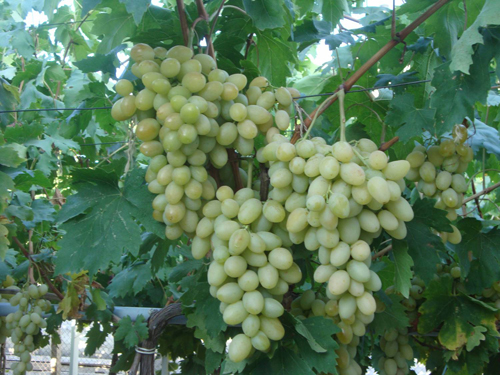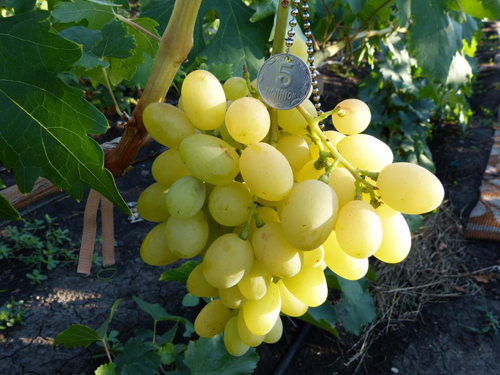Blagovest grape variety
Table grapes called Blagovest are the result of amateur selection, which in recent decades has become a very serious competitor to the traditional research work of scientists from industry research institutes. One of the most significant roles in this process was played by Viktor Krainov, the most famous national breeder, whose period of active work on the hybridization of the "sunny berry" fell on the late 90s and 2000s. During this relatively short period of time, he managed to produce dozens of high-quality varieties of new generation grapes, distinguished by the exceptional splendor of the appearance of the bunches and the high gastronomic characteristics of the berries.

One of these amazing forms of Viktor Nikolaevich was Blagovest, which he received as a result of crossing his beloved parental pair - famous varieties Mascot, domestic selection, and Radiant kishmish, originally from Moldova. After sowing hybrid seeds and a careful selection of the best seedlings, a form was identified, characterized by an early ripening period of large, light-colored fruits, which also have an amazing taste and a bright fruity aroma. Going on sale, the variety very soon fell in love with many winegrowers, and, thanks to
In economic terms, the advantages of our hero are slightly less outstanding, however, here too, definitely positive features are found in him, in particular, good resistance to fungal diseases, which makes it possible to manage with only preventive treatments with plant protection agents during cultivation.
Agrobiological properties
The growth activity of the bushes in this variety is above average. The crown of a young shoot is open, shiny, without pubescence. Her color, like that of young leaves, is greenish, with a barely noticeable bronze tint. A typical leaf of large size, rounded in shape, consists of five lobes, between which there is a fairly strong dissection. The leaf blade is smooth, rich green with prominent light veins. Its profile is slightly funnel-shaped or flat with slightly raised edges of the lobes. The upper side cutouts are deep, open in the shape of a lyre, with a pointed or rounded bottom, but there are also slit-like ones with parallel sides. The lower notches are much smaller, predominantly V-shaped, or barely outlined. The petiole notch is open, broadly vaulted or lancet. The petioles slightly exceed the length of the main vein of the leaf; their color is marked by a bright anthocyanin pigmentation. The teeth along the edge of the leaf are triangular and saw-shaped, of medium size, with convex sides and sharp tops. The flowers are bisexual, due to which their fertilization proceeds well with the participation of their own pollen, and the berries are not subjected to peas. At the same time, some growers complain about the occasional shedding of inflorescences, as a result of which the clusters may appear "disheveled" in appearance. Fortunately, such a defect is rare, and is associated with specific weather conditions during the flowering period. Annual growth ripens on time and for a sufficient length.At the same time, the color of the vine changes to yellowish brown with darker longitudinal stripes.

The large-fruitedness of Blagovest grapes grows with the age of the bushes and the accumulation of perennial wood by them, but already the first, so-called "signal" bunches make an impression even on sophisticated winegrowers. On average, the mass of brushes ranges from 600 to 1200 grams, and the largest specimens weigh up to 2.5 kg. Their density is moderate, the shape is elongated-conical. The free arrangement of the berries in the bunch allows them to avoid deformation, and the good evenness of the grapes gives the brushes a neat and elegant appearance. They are attached to the vine with rather long and strong herbaceous comb, sometimes lignified at the base. Oval or slightly nasal berries also grow large in size, reaching 26 mm in length and 23 mm in diameter. Their usual weight is about 10 - 15 grams. When fully ripe, the color ranges from milky white to amber, with an intense protective waxy coating of a light shade on the surface. The flesh of the fruit is fleshy, quite dense, pleasant fruity notes are noticeable in the taste, and in the aroma, often, light tones of nutmeg. Sugar content of berry juice is very high for table varieties - 19 - 22 g / 100 ml, titratable acidity - 6 - 8 g / l. The skin is firm, but chewable without any problems. There are bones, but they do not have a particular negative effect on the gastronomic quality.
In general, the tasting merits of this grape variety are highly appreciated by amateurs, thanks to which the bulk of the harvest is used for fresh consumption. Even those growers who cultivate the crop for sale on the market admit that they feel sorry for selling a great Blagovest, and usually they use it for food, sharing the surplus with friends and family. And still getting on the shelves, our hero does not stay there for a long time because of his excellent presentation. This attractiveness does not decrease even when the grapes are moved over long distances, which speaks volumes about the good transportability of the grapes.

Farmers also appreciate the early ripening of this variety, due to which the sale of the crop occurs during a period of high prices for the "sun berry", providing a significant profitability of cultivation. So, from the moment the eyes awaken in the spring, about 115 - 125 days pass before the onset of the removable ripeness of the fruit. In traditional wine-growing regions, the first clusters can be cut in the first decade of August, when the sum of active temperatures reaches 2400 - 2500 ° C. The only nuance that must be taken into account in the case of Blagovest is the unevenness of its ripening, which requires selective multiple harvesting.
Due to the rather modest demands of the variety to provide heat, it can be successfully cultivated not only in the south, but also in many areas of the middle zone of the country. At the same time, one should not forget about the average resistance of the aboveground part of the bushes to low winter temperatures (-22 ... -23 ° C), organizing their careful shelter in frost-prone regions.
The hybrid form is distinguished by high productivity, which, in addition to the large size of the bunches, is provided by the high fruitfulness of the shoots. Often on each of them, two or even three brushes are formed, which is a prerequisite for already overloading the crop. This is prevented by the annual rationing of plants by shoots and bunches, which consists in competent spring pruning, a fragment of green barren shoots and thinning out excess inflorescences. On average, the bush is loaded with 30 - 35 eyes with a moderate or short length of fruit arrows.
Blagovest's resistance to major diseases is increased; during the growing season, the bushes need no more than two to three sprays with fungicides.The damage rate by wasps is average, and therefore it will not be superfluous to place ripening bunches in protective bags. There is practically no cracking of the berries.








